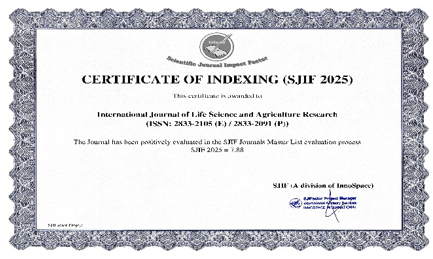Efficiency of Some Nanoparticle Oxides in Controlling Cotton Seedling Pests
DOI:
https://doi.org/10.55677/ijlsar/V04I05Y2025-05Keywords:
Nanoparticles oxides, Egyptian cotton, Seedling pests, Natural enemies.Abstract
The present work assessed the effect of three nanoparticles materials; Titanium dioxide nanoparticles (TiO2NP), silicon dioxide nanoparticles (SiO2NP) and iron oxide nanoparticles (FeO NP) with three different concentrations (500, 250 and 125ppm) on managing Egyptian cotton seedling pests Jassid pest Empoasca lybica (De Berg.) (Hemiptera:Cicadellidae), Whiteflies populations Bemisia tabaci (Gennadius) (Hemiptera: Aleyrodidae), Thrips pest Thrips tabaci Lindeman (Thysanoptera: Thripidae), Aphid (Aphis gossupii Glover), Whitefly (Bemisia tabaci Gennadius), Red spider pest Tetranychus telarius (L.) (Acari: Tetranychidae) and studying their effect on the natural enemies Ladybugs (Coccinellidae ladybug) and Chrysoperla carnea (aphid lion). Under field conditions during 2022 and 2023, the nanoparticles suspensions was sprayed at cotton plants (Gossypium) at the three different concentrations compared with untreated cotton plants as control, the results show that SiO2NP with its three concentrations have the most potent effect in decreasing jassid, aphid, thrips populations count during the two tested years. While TiO2NP has the second effect, FeO NP has the least effect on decreasing the previous pest count on cotton plants during the two tested years. On the other hand, TiO2NP has the most potent effect against the red spider population through its three concentrations, then SiO2 NP and FeONP come in the second and third stage, respectively during the two tested years. The three used nanoparticles and their effect on the ladybug's natural enemy was investigated. The results show there is no negative effect on the ladybug count compared with the untreated cotton plant control. Moreover, at the 250ppm FeONP and 125ppm TiO2NP concentrations, it was noticed that the count of Chrysoperla carnea (aphid lion) and ladybug increased during the two tested years, which led to a decrease in aphid count at this concentration compared with the two other concentrations. Nanoparticles have promising results in pest control as pesticide alternatives.
References
1. Abeer M Mohammad, Ahmed M Shaker, Olfat MA Salem, Alawia Elmashay, Rym Hassani. Screening the larvicidal activity of ZnO, CuO nanoparticles, and neem seed oil extract against the full armyworm Spodoptera frugiperda (J. E. Smith) (Lepidoptera, Noctuidae), Emirates Journal of Food and Agriculture2024, 36: 1–9.
2. Allen, C. T., Kharboutli, M. S., Capps, C., & Earnest, L. (1999). STEWARD^®: NEW INSECTICIDE FOR THE NEW MILLENNIUM. SPECIAL REPORTS-UNIVERSITY OF ARKANSAS AGRICULTURAL EXPERIMENT STATION, 193, 56-64
3. Al-Habshy, A. (2018). Cowpea Aphid Aphis craccivora Koch as Insect Vector of Faba Bean Necrotic Yellow Virus (FBNYV) on Broad Bean Plants. Journal of Plant Protection and Pathology, 9(1), 31-33.
4. Abou El-Ela, A. S., Ntiri, E. S., Munawar, A., Shi, X. X., Zhang, C., Pilianto, J., ... & Zhu, Z. R. (2022). Silver and copper-oxide nanoparticles prepared with GA3 induced defense in rice plants and caused mortalities to the brown planthopper, Nilaparvata lugens (Stål). NanoImpact, 28, 100428
5. Athanassiou, C. G., Kavallieratos, N. G., Benelli, G., Losic, D., Usha Rani, P., & Desneux, N. (2018). Nanoparticles for pest control: current status and future perspectives. Journal of Pest Science, 91, 1-15.
6. Blackman, R. L., & Eastop, V. F. (2008). Aphids on the world's herbaceous plants and shrubs, 2 volume set. John Wiley & Sons.
7. Butler Jr, J. J. (1988). Pumping tests in nonuniform aquifers—The radially symmetric case. Journal of Hydrology, 101(1-4), 15-30.
8. Ghidan, A. Y., Al-Antary, T. M., Awwad, A. M., Ghidan, O. Y., Araj, S. E. A., & Ateyyat, M. A. (2018). Comparison of different green synthesized nanomaterials on green peach aphid as aphicidal potential. Fresenius Environmental Bulletin,27(10), 7009-7016.
9. Mohamed, M. A. "Impact of planting dates, spaces and varieties on infestation of cucumber plants with whitefly, Bemisia tabaci (Genn.)." The Journal of Basic & Applied Zoology 65.1 (2012): 17-20.
10. Mohammed, A., & Aswd, S. (2019). Effect of some nanoparticles on the stages biology of the southern cowpea beetle Callosobruchus maculatus (Fab.)(Coleoptera: Bruchidae). Journal of Education and Science, 28(3), 188-0.
11. N. N. Lv, K. S. Ma, R. Li, P. Z. Liang, P. Liang and X. W. Gao,Ecotoxicol. Environ. Saf., 2021, 212, 111969.
12. Osman, H.H.; Fetoh,B.A.; Mohammed, A.M.(2012). The potency of Chloropyrifos and Camphor extract on Spodoptera littoralis (BOISD.). Egyptian Academic Journal of Biological Sciences, (A.Entomology )Vol.5(2) : 131-139.
13. Patil, S. S., Shedbalkar, U. U., Truskewycz, A., Chopade, B. A., & Ball, A. S. (2016). Nanoparticles for environmental clean-up: a review of potential risks and emerging solutions. Environmental Technology & Innovation, 5, 10-21.)
14. Rouhani, M., Samih, M. A., & Kalantari, S. (2013). Insecticide effect of silver and zinc nanoparticles against Aphis nerii Boyer De Fonscolombe (Hemiptera: Aphididae).
15. Shaker, A.M.; Zaki, A.H.; Abdel- Rahim, E.F. and Khedr, M.H. (2017a): TiO2 nanoparticles as an effective nanopesticide for cotton leaf worm. AgricEngInt: CIGR J., Special issue: 61–68
16. Shaker, A.M.; Zaki, A.H.; Abdel- Rahim, E.F. and Khedr, M.H. (2017b): Novel CuO nanoparticles for pest management and pesticides photodegradation. Adv. Environ. Biol., 10(12): 274-283
17. Sharanabasappa, S., Kalleshwaraswamy, C. M., Asokan, R., Swamy, H. M., Maruthi, M. S., Pavithra, H. B& Goergen, G. (2018). First report of the fall armyworm, Spodoptera frugiperda (JE Smith)(Lepidoptera: Noctuidae), an alien invasive pest on maize in India
18. Sivapriya, V., Azeez, A. N., & Deepa, S. V. (2018). Phyto synthesis of iron oxide nano particles using the agro waste of Anthocephalus cadamba for pesticidal activity against Sitophilus granaries. J. Entomol. Zool. Stud, 6, 1050-1057.
19. Zi-Han Wei, Peng Zhao, Xin-Yuan Ning, Yu-Qing Xie, Zhen Li, and Xiao-Xia LiuJournal of Agricultural and Food Chemistry 2024 72 (38), 20905-20917.
Downloads
Published
Issue
Section
License
Copyright (c) 2025 International Journal of Life Science and Agriculture Research

This work is licensed under a Creative Commons Attribution 4.0 International License.












